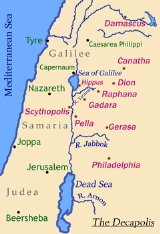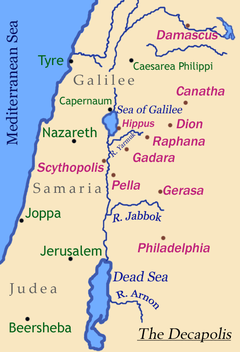
Canatha
Encyclopedia
Qanawat the ancient Roman city of Canatha (also Kanatha), is a village in Syria
, located 7 km north-east of As Suwayda
. It stands at a height of about 1,200 m, near a river and surrounded by woods.

(1st century BC), when Nabatean Arab forces defeated a Jewish army. It remained an issue of contention between the two powers. From the Pompey
's time until Trajan
's it was a city of the Decapolis
, a loose federation of cities allowed by the Romans to enjoy a degree of autonomy. In the 1st century AD it was annexed to the Roman province of Syria, and in the 2nd century it was rechristened Septimia Canatha by Septimus Severus, and transferred to the province of Arabia.
A center of Christianism propagation in the area, Canatha was captured by the Muslim Arabs in 637
, declining in importance until, in the 9th century, it was reduced to a poor village.
, with nine tiers of seats and an orchestra nineteen meters in diameter, also a nymphaeum
, an aqueduct, and a large prostyle temple with portico and colonnades. North-west of the town is a late 2nd or early 3rd century peripteral temple, built on a high platform surrounded by a colonnade. For years, this temple was believed to honour Helios
, but an inscription discovered in 2002 shows that it was dedicated to a local god, Rabbos.
The monument known as Es-Serai (also Seraya, "palace") dates from around the 2nd century AD and was originally a temple, and then, from the 4th/5th centuries, a Christian
basilica
. It is 22 m long, and was preceded by an outside portico and an atrium with eighteen columns.
Syria
Syria , officially the Syrian Arab Republic , is a country in Western Asia, bordering Lebanon and the Mediterranean Sea to the West, Turkey to the north, Iraq to the east, Jordan to the south, and Israel to the southwest....
, located 7 km north-east of As Suwayda
As Suwayda
As Suwayda , also spelt Sweida, is a mainly Druze city located in southwestern Syria, close to the border with Jordan.It is the capital of Muhafazat as Suwayda, one of Syria's 14 governorates, bordering Jordan in the South and the governorates of Daraa in the West and Rif Dimashq in the North and...
. It stands at a height of about 1,200 m, near a river and surrounded by woods.

History
The town is mentioned for the first time in the reign of Herod the GreatHerod the Great
Herod , also known as Herod the Great , was a Roman client king of Judea. His epithet of "the Great" is widely disputed as he is described as "a madman who murdered his own family and a great many rabbis." He is also known for his colossal building projects in Jerusalem and elsewhere, including his...
(1st century BC), when Nabatean Arab forces defeated a Jewish army. It remained an issue of contention between the two powers. From the Pompey
Pompey
Gnaeus Pompeius Magnus, also known as Pompey or Pompey the Great , was a military and political leader of the late Roman Republic...
's time until Trajan
Trajan
Trajan , was Roman Emperor from 98 to 117 AD. Born into a non-patrician family in the province of Hispania Baetica, in Spain Trajan rose to prominence during the reign of emperor Domitian. Serving as a legatus legionis in Hispania Tarraconensis, in Spain, in 89 Trajan supported the emperor against...
's it was a city of the Decapolis
Decapolis
The Decapolis was a group of ten cities on the eastern frontier of the Roman Empire in Judea and Syria. The ten cities were not an official league or political unit, but they were grouped together because of their language, culture, location, and political status...
, a loose federation of cities allowed by the Romans to enjoy a degree of autonomy. In the 1st century AD it was annexed to the Roman province of Syria, and in the 2nd century it was rechristened Septimia Canatha by Septimus Severus, and transferred to the province of Arabia.
A center of Christianism propagation in the area, Canatha was captured by the Muslim Arabs in 637
637
Year 637 was a common year starting on Wednesday of the Julian calendar. The denomination 637 for this year has been used since the early medieval period, when the Anno Domini calendar era became the prevalent method in Europe for naming years.- Europe :* Battle of Mag Rath: Dál Riata influence...
, declining in importance until, in the 9th century, it was reduced to a poor village.
Main sights
The city's extensive ancient ruins are 1500 m in length and 750 m in breadth. Among them are a Roman bridge and a rock-hewn theatreRoman theatre
Roman theatre may refer to:*Theatre of ancient Rome, the theatrical styles of Ancient Rome*Roman theatre , the theatre buildings of Ancient Rome...
, with nine tiers of seats and an orchestra nineteen meters in diameter, also a nymphaeum
Nymphaeum
A nymphaeum or nymphaion , in ancient Greece and Rome, was a monument consecrated to the nymphs, especially those of springs....
, an aqueduct, and a large prostyle temple with portico and colonnades. North-west of the town is a late 2nd or early 3rd century peripteral temple, built on a high platform surrounded by a colonnade. For years, this temple was believed to honour Helios
Helios
Helios was the personification of the Sun in Greek mythology. Homer often calls him simply Titan or Hyperion, while Hesiod and the Homeric Hymn separate him as a son of the Titans Hyperion and Theia or Euryphaessa and brother of the goddesses Selene, the moon, and Eos, the dawn...
, but an inscription discovered in 2002 shows that it was dedicated to a local god, Rabbos.
The monument known as Es-Serai (also Seraya, "palace") dates from around the 2nd century AD and was originally a temple, and then, from the 4th/5th centuries, a Christian
Christian
A Christian is a person who adheres to Christianity, an Abrahamic, monotheistic religion based on the life and teachings of Jesus of Nazareth as recorded in the Canonical gospels and the letters of the New Testament...
basilica
Basilica
The Latin word basilica , was originally used to describe a Roman public building, usually located in the forum of a Roman town. Public basilicas began to appear in Hellenistic cities in the 2nd century BC.The term was also applied to buildings used for religious purposes...
. It is 22 m long, and was preceded by an outside portico and an atrium with eighteen columns.

